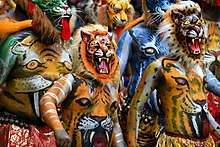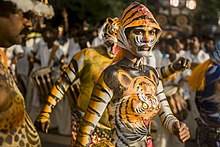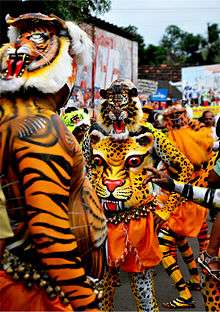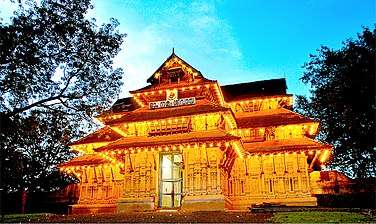Puli Kali
Pulikkali ("Puli" = Leopard/Tiger & "Kali" = Play in Malayalam language) is a recreational folk art from the state of Kerala.[1] It is performed by trained artists to entertain people on the occasion of Onam, an annual harvest festival, celebrated mainly in the Indian state of Kerala. On the fourth day of Onam celebrations (Nalaam Onam), performers painted like tigers and hunters in bright yellow, red, and black dance to the beats of instruments like Udukku and Thakil. Literal meaning of Pulikkali is the 'play of the tigers' hence the performance revolve around the theme of tiger hunting. The folk art is mainly practiced in Thrissur district of Kerala. Best place to watch the show is at Thrissur on the fourth day of Onam, where Pulikkali troupes from all over the district assemble to display their skills. The festival attracts thousands of people to the Thrissur city. Pulikkali is also performed during various other festive seasons.
| Pulikkali പുലിക്കളി | |
|---|---|
 | |
| Genre | Pulikkali (Tiger Dance) |
| Dates | 4th Onam day in the month of Chingam |
| Founded | 1886 |
History
The origin of Pulikkali dates back to over 200 years, when the Maharaja Rama Varma Sakthan Thampuran, the then Maharaja of Cochin, is said to have introduced the folk art, who wanted to celebrate Onam with a dance that reflected the wild and macho spirit of the force. Later, Konar of (Pattalam Road) used to celebrate with great fervor. They popularised the folk genre with steps and body language peculiar to a tiger being stalked by a hunter, enacting a play of the hunter and the beast. Along with the celebrations, they used to perform the art form decked as tigers with peculiar steps resembling the tiger, then known as 'Pulikkettikali' which was immensely enjoyed by the locals. Pulikkali in Thrissur is held in memory of this event.[2]
Modern

Over the years, there has been changes in the adornment of Pulikkali dancers. In the early days, masks were not used and participants would have themselves painted all over, on their faces as well. But now, ready made masks, cosmetic teeth, tongues, beards and mustaches are used by the participants along with the paint on their bodies. The tigers also wear a broad belt with jingles around their waist. The festival in Thrissur has now become an all peoples event with huge response from people, especially youths who come forward to participate in the festival, and also from sponsors. The event is organized by the Pulikkali Co-ordination Committee, a unified council of Pulikkali groups formed in 2004 in Thrissur to preserve and propagate the art in all its true hues and tones. The Thrissur Municipal Corporation give a grant of Rs 30,000 for each Pulikkali troupe.
A striking feature of this folk art is the colorful appearance of the performers. A particular combination of tempera powder and varnish or enamel is used to make the paint. First of all, the dancers remove the hair from the body, and then, the base coat of paint is applied on them. It takes two to three hours for the coating to dry. After that, the second coat of paint is applied with enhanced design. This entire procedure takes at least five to seven hours. A large number of artists gather to apply paint on the tigers. It is a meticulous process and often starts from the wee hours in the morning. By afternoon the Pulikkali groups or 'sangams' as they are called, from all four corners of Thrissur move in a procession, dancing, pouncing and shaking their bellies to the beat of the drums through the streets to the Swaraj Round, Thrissur situated in the heart of the city through Palace Road, Karunakaran Nambiar Road, Shornur Road, A R Menon Road and MG Road.

Scenes such as the tiger preying on an animal, and a tiger being hunted by a game-hunter are enacted beautifully in between. Thousands of spectators line the streets enjoying the dance, cheering the dancers some of them even trying to join in. The groups assemble at Naduvilal in the Swaraj Round, Thrissur in front of the Vadakkunnathan Temple and offer a coconut each to the deity of the Ganapati shrine (Naduvilal Ganapati Kovil) here, before going on a procession around the ground. The procession also include floats from each village. The different troupes vie with each other to make the best floats as well as the best dressed tigers.
References
- Pulikkali Procession on the occasion of Athachamayam celebrations in Tripunithura, Kerala, Musicmalt.com
- "Colourful tiger art with folk dance for Onam". Sify. Retrieved 12 September 2010.
External links
| Wikimedia Commons has media related to Puli Kali. |
